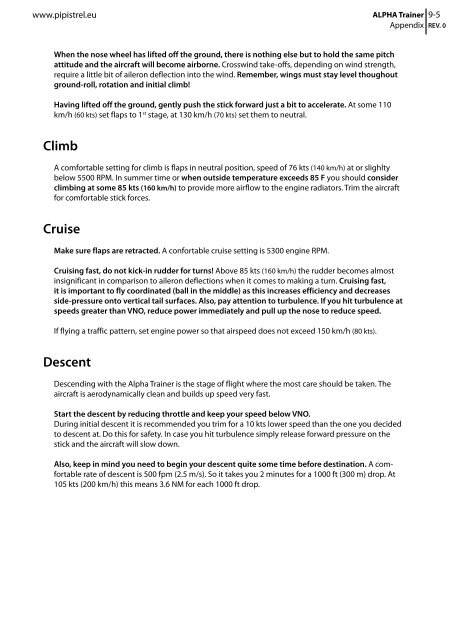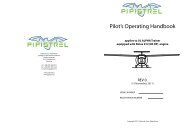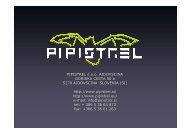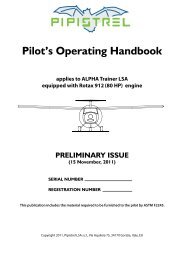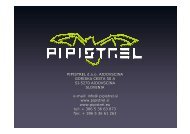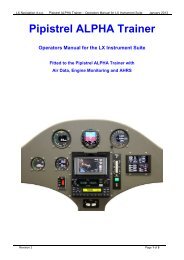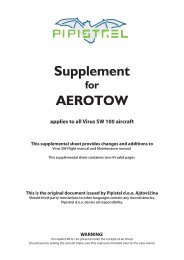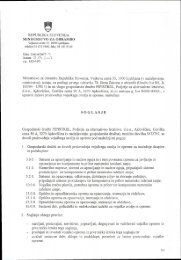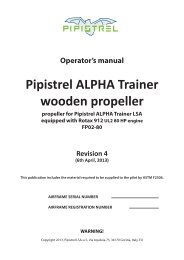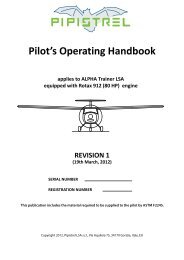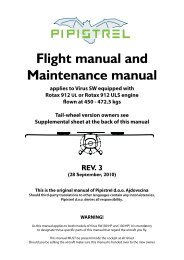Create successful ePaper yourself
Turn your PDF publications into a flip-book with our unique Google optimized e-Paper software.
www.pipistrel.eu<br />
<strong>ALPHA</strong> <strong>Trainer</strong> 9-5<br />
Appendix REV. 0<br />
When the nose wheel has lifted off the ground, there is nothing else but to hold the same pitch<br />
attitude and the aircraft will become airborne. Crosswind take-offs, depending on wind strength,<br />
require a little bit of aileron deflection into the wind. Remember, wings must stay level thoughout<br />
ground-roll, rotation and initial climb!<br />
Having lifted off the ground, gently push the stick forward just a bit to accelerate. At some 110<br />
km/h (60 kts) set flaps to 1 st stage, at 130 km/h (70 kts) set them to neutral.<br />
Climb<br />
A comfortable setting for climb is flaps in neutral position, speed of 76 kts (140 km/h) at or slighlty<br />
below 5500 RPM. In summer time or when outside temperature exceeds 85 F you should consider<br />
climbing at some 85 kts (160 km/h) to provide more airflow to the engine radiators. Trim the aircraft<br />
for comfortable stick forces.<br />
Cruise<br />
Make sure flaps are retracted. A confortable cruise setting is 5300 engine RPM.<br />
Cruising fast, do not kick-in rudder for turns! Above 85 kts (160 km/h) the rudder becomes almost<br />
insignificant in comparison to aileron deflections when it comes to making a turn. Cruising fast,<br />
it is important to fly coordinated (ball in the middle) as this increases efficiency and decreases<br />
side-pressure onto vertical tail surfaces. Also, pay attention to turbulence. If you hit turbulence at<br />
speeds greater than VNO, reduce power immediately and pull up the nose to reduce speed.<br />
If flying a traffic pattern, set engine power so that airspeed does not exceed 150 km/h (80 kts).<br />
Descent<br />
Descending with the Alpha <strong>Trainer</strong> is the stage of flight where the most care should be taken. The<br />
aircraft is aerodynamically clean and builds up speed very fast.<br />
Start the descent by reducing throttle and keep your speed below VNO.<br />
During initial descent it is recommended you trim for a 10 kts lower speed than the one you decided<br />
to descent at. Do this for safety. In case you hit turbulence simply release forward pressure on the<br />
stick and the aircraft will slow down.<br />
Also, keep in mind you need to begin your descent quite some time before destination. A comfortable<br />
rate of descent is 500 fpm (2.5 m/s). So it takes you 2 minutes for a 1000 ft (300 m) drop. At<br />
105 kts (200 km/h) this means 3.6 NM for each 1000 ft drop.


